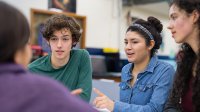3 SEL Practices Teachers Can Use Every Day
These social and emotional learning strategies won’t take a lot of time, but they can have a big impact on middle and high school students.
Your content has been saved!
Go to My Saved Content.How do you feel about the phrase soft skills? For me (and for many), skills such as critical thinking, empathy, creativity, and teamwork are not soft skills. These are essential skills or center skills. Decision-making, self-awareness, and self-regulation are at the center of learning and life. We need to start with, build from, and embed social and emotional learning (SEL) into safe, equitable, empowering learning experiences for all students.
Regardless of your teaching and learning situation (fully online, hybrid, or in person), we know that the intentional and explicit weaving of SEL into the fabric of our everyday learning and life is critical. Below are three SEL signature practices from the Collaborative for Academic, Social, and Emotional Learning (CASEL) that we need to bring in whenever we come together as a community of learners. Included are examples that are simple, portable, and customizable. Consider your scenario as well as the needs and size of your group when deciding whether to take turns sharing out loud, use the chat, or break into small groups or pairs.
3 SEL Practices for Every Day
1. Welcoming or inclusion activities. Rather than jumping right into instruction, starting with brief routines and rituals provides us with interactive experiences that give everyone a voice and connects the community of learners. A few examples:
- Use opening check-ins to give students an opportunity to identify their emotions (self-awareness). We can provide scaffolding by using tools such as Zones of Regulation or the Mood Meter. We can also use images and word banks to help build vocabulary.
- Have a kindness conversation asking everyone to share an act of kindness they have given or received recently (social awareness).
- Inspired by Brené Brown, permission slips help us set our intention and focus. Share examples such as, “I give myself permission to make a mistake and try again.” Then ask students to create their own permission slip (self-management).
2. Engaging strategies. There are many SEL opportunities throughout learning experiences where learners are naturally engaged both individually and with their peers. As educators, we often use engaging strategies like breakout rooms/small group discussions, wait time, brain breaks, jigsaw, etc. However, we still need to be explicit with SEL. A few examples:
- Cocreate shared expectations ahead of time for collaborative work, and revisit regularly to ensure that everyone’s needs are being met (relationship skills, responsible decision-making, social awareness).
- Design for inquiry with voice and choice to provide opportunities for learners to construct meaning through communication and collaboration with their peers. Using an approach like Discover, Discuss, Demonstrate gives learners opportunities to explore content before direct instruction (relationship skills, responsible decision making, self management).
- Incorporate movement breaks to refresh and reset the brain. These brain breaks could be a stretch or a mindful breathing practice. Depending on what suits the situation, the break could be to calm or to energize (self-management).
As we plan to use engaging strategies, activities, and protocols, we need to offer both interactive and reflective options. It is also important to make time to debrief these experiences, allowing us to identify and connect what we are doing to SEL competencies and specific skills. Notice that so much of this is also aligned with Universal Design for Learning (UDL).
3. Optimistic closure. The name of this practice often leads to the misconception that we need to end on a happy note. The reality is that what is most important about this practice is the intentional and authentic reflection and understanding of the learning experience. This allows us to both collectively and individually appreciate what we have accomplished and anticipate what comes next. A few examples:
- We can reflect doing a closing check-in on emotions by simply asking something like, “Which one to two words sum up your feelings about our time together?” (self-awareness).
- Another way to reflect is through a gratitude practice (social awareness). Ask learners to acknowledge something or someone that they are thankful for. Guide them to think deeply and name the feelings they are experiencing (self-awareness).
- The goal of looking ahead is to get us excited moving forward, and it is also an opportunity to hold ourselves accountable through goal setting and organization. Use a planner and/or set a reminder to execute next steps. You could even use a service like FutureMe.org to send your future self a reminder of long-term goals (self-management).
These are just a few ways to implement the three signature practices, and additional examples are available here. The reality is, there are countless ways to use these practices. Collaborate with your learners and your peers to adapt and create practices to meet the specific goals and needs of your community. Your team can even use the “Getting It Down PATT!”—Purpose, Alignment, Transparency, Target (created by Micaela Gerardin-Frey) as a tool to thoughtfully select, adapt, and prepare strategies, activities, and protocols.
Emotions matter, and the research on how emotions impact learning is clear. But it isn’t just about accepting SEL’s necessity as a means to increased academic performance. Using the three signature practices as part of a systemic SEL approach allows us to create safe, equitable, empowering learning experiences for all, kids and adults.
